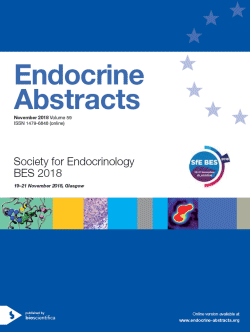
Society for Endocrinology BES 2018
Glasgow,
UK
19 Nov 2018 - 21 Nov 2018

Oral Communications
Translational highlights
ea0059oc1.1 | Translational highlights | SFEBES2018
Resilient reproductive, bone and adrenal function in Expedition Ice Maiden, the first all-female, unassisted Antarctic crossing
Gifford Robert , O'Leary Thomas , Greeves Julie , Anderson Richard , Reynolds Rebecca , Woods David
ea0059oc1.2 | Translational highlights | SFEBES2018
Vitamin D insufficiency and elevated vitamin D metabolite ratios (VMR) are associated with increased risk of injuries: Results from the british army lower limb injury prevention (ALLIP) study
Tang Jonathan , Jackson Sarah , Izard Rachel , Oliver Samuel , Piec Isabelle , Washbourne Christopher , Walsh Neil , Greeves Julie , Fraser William
ea0059oc1.3 | Translational highlights | SFEBES2018
Novel insights into the genetic architecture of thyroid disease
Taylor Peter , Anney Richard , Dayan Colin , Ludgate Marian , Rees Aled
ea0059oc1.4 | Translational highlights | SFEBES2018
Whole genome sequence analysis establishes correct diagnosis for a syndromic form of hyperuricaemia
Stevenson Mark , Pagnamenta Alistair T , Reichart Silvia , Mennel Stefan , Philpott Charlotte , Lines Kate E , Gorvin Caroline M , Lhotta Karl , Taylor Jenny C , Thakker Rajesh V
ea0059oc1.5 | Translational highlights | SFEBES2018
In vivo and ex vivo metabolomics in succinate dehydrogenase deficient tumorigenesis
Casey Ruth , Basetti Madhu , McLean Mary , Challis Ben , Gallagher Ferdia , Maher Eamonn
ea0059oc1.6 | Translational highlights | SFEBES2018
Germline CYP2W1*6 and CYP2B6*6 polymorphisms as predicting markers of sensitivity to mitotane treatment in advanced adrenocortical carcinoma: a multicentric ENSAT study
Altieri Barbara , Herterich Sabine , Sbiera Silviu , Volante Marco , Francia Silvia De , Casa Silvia Della , Pontecorvi Alfredo , Quinkler Marcus , Kienitz Tina , Mannelli Massimo , Canu Letizia , Chortis Vasileios , Kaltsas Gregory , Kroiss Matthias , Terzolo Massimo , Fassnacht Martin , Ronchi Cristina L



